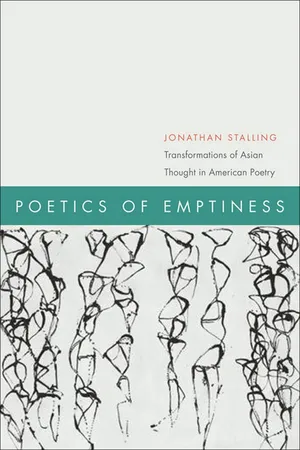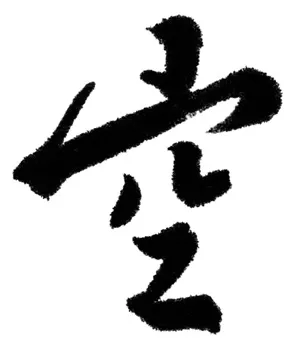![]()
PART ONE
BUDDHIST IMAGINARIES
![]()
1 / Emptiness in Flux: The Buddhist Poetics of Ernest Fenollosa’s “The Chinese Written Character as a Medium for Poetry”
On Friday, December 24, 1920, the front-page headline of the Boston Evening Transcript announced “Japan’s Tribute to Fenollosa.” Below, an image of a stone monument depicting a young Ernest Fenollosa fills more than half of the front page. The article begins: “On September 21, 1920, in the ninth month of the ninth year of Taisho—Japan in a memorial service formally honored the late Professor Ernest Fenollosa by the unveiling of a monument to him and his work for Japan—his interpretation of Japan to the non-Asiatic world, and its corollary, expounding the Western world to Nippon.” The image and accompanying text present Fenollosa as a towering influence within the history of transpacific (specifically Buddhist East-West) cultural migrations. As reported by the Evening Transcript, the monument reads: “Professor Fenollosa was a great believer in the Buddhist religion. After long study he became a convert to it, and he received baptism from the abbot Sakurai Keitoku [桜井敬徳] of Enjo-ji. His Buddhist name is Tei-Shin.”1
Tei-Shin was the first Euro-American poet to receive a Buddhist name, but he would soon be joined by a sangha (Buddhist community) of American poets ranging from Zenshin Ryufu (Phillip Whalen) to Ho-Ka (Armand Schwerner). Even though Ernest Fenollosa was one of the first Westerners to become a lay-ordained Buddhist, his work in poetics has never been read in relation to his Buddhist studies or practice. This is, of course, not to say that Fenollosa’s essay, “The Chinese Written Character as a Medium for Poetry” (henceforth abbreviated in text and notes as CWC), has been ignored with regard to the study of Modernism’s transpacific origins. Ernest Fenollosa’s essay not only stands at the center of East-West studies of American poetry,2 it remains one of the most important prose works in twentieth-century American poetry and poetics more generally. In the eyes of Ezra Pound, the essay’s editor and its greatest supporter, it is “a study of the fundamentals of all aesthetics.”3 The English critic Donald Davie considered the essay “perhaps the only English document of our time fit to rank with Sidney’s Apologia, and the Preface to Lyrical Ballads, and Shelley’s Defense.”4 Other giants of American literature, including Charles Olson, also reserved a special place for it.5 Fenollosa’s essay appears at the beginning of Donald Allen’s seminal anthology, The Poetics of the New American Poetry, and it has remained available in a small-bound edition published in 1964 by City Lights Books to the present day. The editorial blurb on the back of the City Lights edition gives contemporary readers a glimpse into the essay’s controversial past and, I would argue, offers a clear indication as to why its Buddhist orientation has remained obscure through to the present:
This important and much-disputed essay edited by Ezra Pound from the manuscript of Ernest Fenollosa (and published in Instigations, London, 1920) has since gone through several editions, despite the ridicule of such sinologists as Professor George Kennedy of Yale, who called it “a small mass of confusion.”
The old theory as to the nature of the Chinese written character (which Pound and Fenollosa followed) is that the written character is ideogrammic—a stylized picture of the thing or concept it represents. The opposing theory (which prevails today among scholars) is that the character may have had pictorial origins in prehistoric times but that these origins have been obscured in all but a few very simple cases, and that in any case native writers don’t have the original pictorial meaning in mind as they write.
Whether Pound proceeded on false premises remains an academic question. Let the pedants rave. An important extension of imagist technique in poetry was gained by Pound’s perception of the essentially poetic nature of the Chinese character as it is still written.
In this short blurb we are told that scholars object to the essay’s support of the “old idea” that Chinese characters are “a stylized picture of the thing or concept it represents,” but that “whether Pound proceeded on false premises remains an academic question.” The blurb, therefore, offers readers what appears to be a live debate between Pound’s supporters (poets) and detractors (academics), who take different sides in a continuing debate over the nature of the “ideogram.” But the editors’ use of phrases like “an academic question” or “let the pedants rave” reveals that the detractors stand in the unenviable position of being “square,” or too narrowly focused on unimportant technical distinctions—not so dissimilar from “Trekkies” (or “Trekkers,” as I understand they prefer to be called) unhappy with misspelled “Klingon.” In short, poets appear to have offered Fenollosa a pardon, and in many cases appear to legitimize the incorrect belief in ideogrammic pictures. This understanding of the text and its influence on a wide reading public has made Fenollosa into a dirty word in sinology.
With tongue partly in cheek, Haun Saussy highlights the danger the text poses to sinologists who even mention Fenollosa in their writing:
WARNING. The following section contains passages from the writings of Ernest Fenollosa that may be objectionable to some readers. The reproduction of these statements does not indicate endorsement or approval of their content by the author or the Press, or the President and Fellows of Harvard College, who decline all responsibility for any damages, direct or incidental, that may result from the reading of them….
Saussy continues: “Having a professional interest in Chinese literature, I know I expose myself to trouble simply for having mentioned Fenollosa’s name. As we learn very early in our training, Fenollosa was an enthusiast: in his wonderment at the Chinese language, he vastly overestimated the number of primary pictograms in the writing system…. The profession has never forgotten his error.”6 While it is perfectly understandable that Chinese linguists like Peter Bodburge and George Kennedy take Fenollosa to task for his linguistic errors, literary critics have become just as harsh, but for different, and I would argue, less legitimate reasons. Most contemporary literary critics follow the reading of Fenollosa presented in Hugh Kenner’s critical juggernaut The Pound Era, in which he paints Fenollosa’s poetics as a derivative transcendentalist hallucination. By juxtaposing quotes from Fenollosa’s CWC next to Emerson’s essays “The Poet” (1844) and “The Method of Nature” (1841), Kenner unjustly claims that “we can collect without trouble a body of propositions indistinguishable in import from the statements about reality out of which Fenollosa’s great Ars Poetica is educed.”7
In an even more dismissive tone, Kenner rejects the originality of Fenollosa’s work by quoting Emerson (who is himself quoting a proverb), “He that would bring home the wealth of the Indies … must carry out the wealth of the Indies,” and then comments, “Ernest Francisco Fenollosa (1853–1908), born in Salem and educated at Harvard, took with him to Japan in 1878 as Professor of Philosophy (Hegel, Herbert Spencer) the treasures of Transcendentalism, and brought with him from Japan on his last journey in 1901 the same Transcendentalism, seen anew in the Chinese Written Character.”8
While Kenner is right to note the influence of Emerson’s thinking on the CWC (and one would need to include William James here as well), his idea that Fenollosa’s work never moved past his Harvard education even after two decades of intensive study and immersion in East Asian art, politics, literature, and philosophy is unconvincing. By taking Kenner’s convenient dismissal to heart, however, scholars of American Modernism (and even East-West studies) have relieved themselves of the burden of exploring Fenollosa’s rich heterocultural poetics, and in the end they ignore the complex cultural and historical conditions that give rise to what Yunte Huang calls the “transpacific displacement” at the very foundation of American Modernism.9
The most recent interpretive angle on Fenollosa’s “ideogrammic error” comes from literary critics like Robert Kern, who has pointed to Fenollosa’s reading of Chinese characters as an Orientalist imposition (à la Edward Said). In Kern’s trendsetting work, Orientalism, Modernism, and the American Poem, he argues that Fenollosa’s CWC continues to represent “the recurrent nature of the role that Chinese seems to play in Western linguistic projects.” He continues, “What I have in mind here specifically is the ‘Adamic’ doctrine that language, in poetry and other modes of discourse as well, can achieve a penetration to the truth or essences of things.”10 Therefore, Kern argues that Fenollosa’s idealization of Chinese reflects the uniquely Western search (grounded in a certain reading of Emersonian transcendentalism inherited by American poetics) for the Adamic language of absolute mimesis. Kern concludes that Fenollosa, “regardless of [his] knowledge (or lack of it) of Chinese, [is] motivated by a concept of linguistic possibility that is entirely Western.”11
Yet there is an important interpretive error at the very foundation of both Fenollosa’s detractors and supporters: namely, that he, like Pound, says that characters are “stylized pictures of things.” Pound believed this—Feanollosa did not. In fact, what he does assert is that characters, unlike alphabetic writing, make it impossible (or much less likely) to mistakenly assume that words or the things they signify “exist autonomously,” because it is clear that they arise “dependently” as aggregates of their causes and conditions. The argument that Fenollosa pursues an Adamic language or that his thinking is derivative wholly from transcendentalism can only be arrived at if his writing remains cut off from its historical and heterocultural (Buddhist) contexts. The present chapter, therefore, will challenge the “monocultural” reading of the text by situating Fenollosa’s work within his peculiar historical context to reveal a startlingly rich heterocultural poetics characterized by a complex weave of Western philosophy and Buddhist epistemology (as unique then as today).
Why have literary critics (even sinologists) rarely if ever addressed Fenollosa’s Asian religious/philosophical study and practice? The answer is complex. I have already pointed to one of the most obvious reasons: Buddhism is not principally interested in finding an “Adamic language,” and as long as Fenollosa’s readers believe that he was ultimately seeking a language of perfect mimesis, then his project appears to be fueled by an “entirely Western” desire. Yet another reason can be attributed to the relationship between Fenollosa’s writing and his principal editor and supporter, Ezra Pound. It is only natural that Fenollosa’s essay would be largely read through the prism of Pound’s own reading, since Pound edited, published, popularized, and continually defended the essay throughout his long career. Nor is it surprising that Pound, who aligned himself with (his positivist reading of) Confucianism,12 reserved ...


